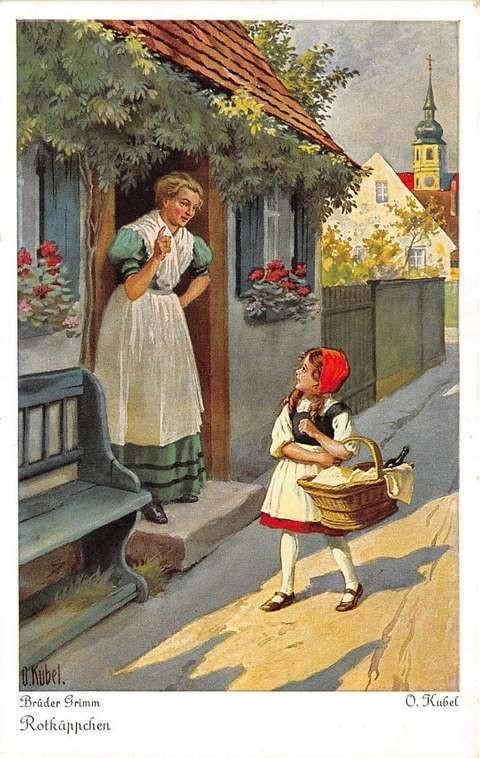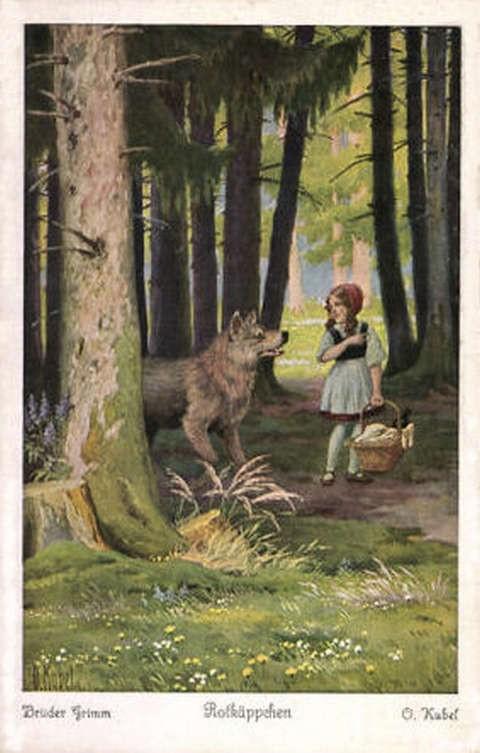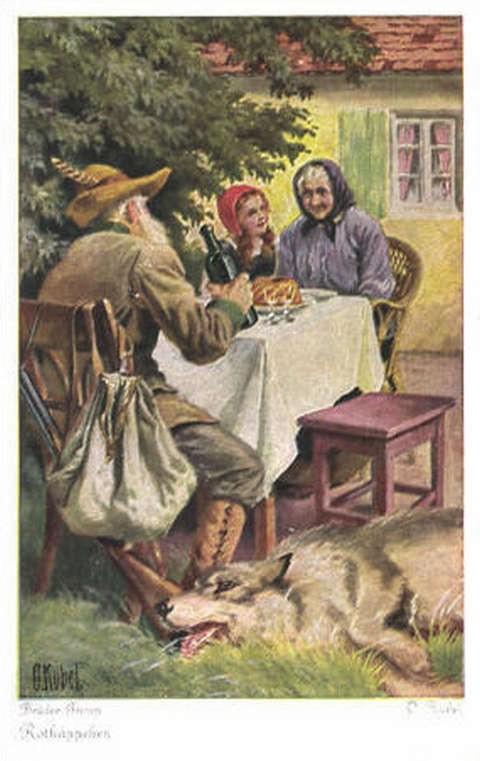Otto Kubel first illustrated Red Riding Hood for the book (probably around 1920) and later (in 1930) Uvachrome used most (or all, we don't have this data, unfortunately) of these illustrations or a series of six picture postcards, just one of the numerous series based on Grimms' fairy tales which were very popular in the first decades of the 20th century.
We will present all six postcards about Red Riding Hood with short comments and explanations.

Red Riding Hood is leaving her home and her mother is giving her some advice. We probably all know the story in different versions but in essence, the girl must go to the woods where her grandmother lives. Granny is sick, so some food and drink (a bottle of wine is a well-known medication) would be cordially welcomed.
Mother of Red Riding Hood looks pretty strict. The girl should not leave the path leading to her granny's house and she should not talk to strangers. Such prohibitions are almost a must in classic fairy tales and this one is no exception. Breaking them is what makes a story (and life) interesting.

Here we are. Instead of rushing through the shortest way to her destination, Red Riding Hood stops to have a chat. Her interlocutor is not just a stranger. He is a full-sized wolf which makes him dangerous but the girl doesn't look worried at all. She is young and naive and she obviously didn't pay too much attention to her mother's pieces of advice.
Otto Kubel decided to portray the wolf very realistically. Many other illustrators of this fairy tale decided to take a different approach and made the wolf way more similar to a human. Large, dangerous male. Well, Kubel's wolf looks dangerous too. He could easily attract the girl on the spot but he wants more. He wants to know where is she going and then where exactly her grandmother lives.
This way he could eat both - the girls and the old lady. When he gets all the necessary information, he suggests Red Riding Hood pick some flowers so the ill granny can enjoy their beauty and freshness.

Here we are again. Red Riding Hood is breaking another of her promises. She left the way to her original destination. She made a detour to a meadow with beautiful flowers while the wolf was hurrying to the granny's house in the woods.
It seems like Red Riding Hood completely forgot about the sick woman waiting for her bottle of wine and other medication. The girl just enjoys the sunny day, picking flowers and making a bouquet. Yes, the flowers are for granny but we can't deny the girl's satisfaction.
Otto Kubel decided to put the girl and the wolf in the same picture again. While before they were both in the same situation (talking) for an uneducated observer this time the difference is obvious. Red Riding Hood lives in the moment like a typical immature child, the wolf has a clear goal like every serious grown-up should.

This picture presents the wolf dressing in the grandmother's nightgown. The illustrator decided for this scene instead of the confrontation or wolf's knocking at the door which is another popular setting among other artists who pictured the same fairy tale.
The wolf in the old lady's attire looks a bit comical and this postcard was probably pretty popular with the audience. We still know that the wolf ate the grandmother and the naive girl is next but still manage to giggle at least a bit looking at the beast in the nightgown with laces.

Here she is, finally. Red Riding Hood brought a bouquet and a basket full of goods to her granny's house. But something is wrong with the old lady. She doesn't look like herself. She is unbelievably hairy. And she has very large eyes. And large claws instead of nails. And a large muzzle instead of her mouth ...
At this point, I would like you to pay attention to the curtains of grandmother's bed. Otto Kubel decided to draw them (he could draw a bed without curtains, but the addition of them helped with the wolf's mask and also created some mystery) in purple color. Purple is not a very common color in classic illustrations of fairy tales. It's pretty rarely used, actually.
Yet in this case it was used for slippers as well. Maybe that's a coincidence but we can't deny the symbolism connected to the color purple. It's closely associated with many meanings and some of them seem more than appropriate for the situation:
Power - wolf is obviously in the position of power
Wisdom - wolf gots it and Red Riding Hood doesn't
Mystery - Red Riding Hood doesn't understand what's going on
Magic - something magical (two victims of the wolf will be saved in a very strange way soon)
etc.
We can add that purple has a very special place in the Christian Church. The basis of Christianity is a resurrection and a simplified way of resurrection is going to happen. Several folklorists actually explained the Fairy Tale of Red Riding Hood as a tale of resurrection and rebirth.

The last scene in the series of postcards about Red Riding Hood by Otto Kubel is the most optimistic. There is a hunter shining in the well-deserved glory after killing the beast and saving two human beings. The granny and the girl look as happy as somebody who was just eaten by the wolf and saved should look.
But Kubel decided to put the dead wolf on the scene too. Maybe as proof that the danger is over. Maybe as a warning. Don't stray from the path. Don't talk to strangers. Don't get eaten by anybody.
If you enjoyed the article, share it with your friends and maybe with some strangers. Cheers!